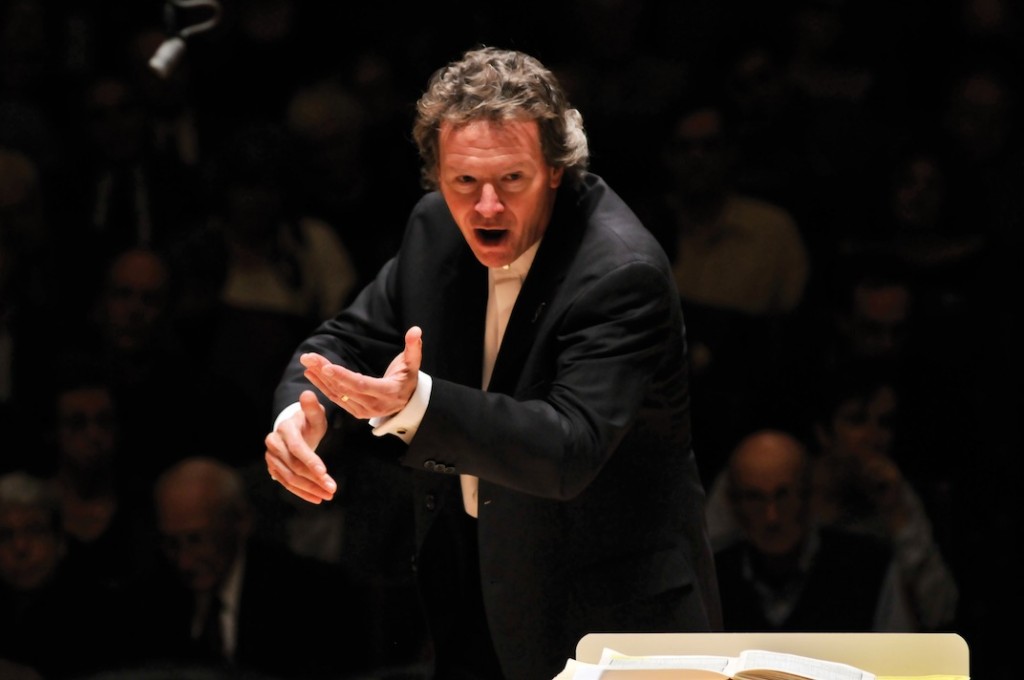H&H, Christophers brilliantly serve Handel and Vivaldi vocal works

Harry Christophers led the Handel and Haydn Society in a program of Handel and Vivaldi Friday night at Symphony Hall. Photo: Stu Rosner
The Handel and Haydn Society have presented plenty of successful concerts with guest conductors over the years. But whenever music director Harry Christophers returns to the podium, as he did at Symphony Hall Friday night, one can immediately tell the difference.
Bracing, coherent, and thoroughly sensitive, H&H’s program of works by Vivaldi and Handel featured the period-instrument orchestra and chorus in one of their most brilliant performances of the current season.
The centerpiece was Vivaldi’s Gloria. This most famous of the composer’s religious works is a tapestry of contemporary styles. The choruses and arias have the immediacy and drama of operatic writing, and the orchestration makes use of the dexterous solos and ritornello forms found in concerti.
The H&H chorus, joined by the Young Women’s Chamber Choir, sang splendidly in the work’s florid and lyrical lines. The somber, penetrating strains of “Et in terra pax” rose from earthly depths. “Domine Fili unigenite,” was buoyant in its dotted-rhythm energy, and the singers pulled off the concluding fugato, “Cum Sancto Spiritu,” with charm and precision.
The stellar cast of soloists, drawn from H&H’s ranks, featured some of the finest singers in town.
Soprano Sonja Tengblad and alto Katherine Growdon offered a robust “Laudamus te.” “Domine Deus,” cast in a lilting siciliana, showcased soprano Margot Rood in supple and expressive singing to match the delicate phrases of the solo oboe. Alto Margaret Lias’ singing was both warm and haunting in the “Agnus Dei,” with Guy Fishman’s cello line added poignant sorrow. Then there was Emily Marvosh, whose velvety and quivering voice, as if pleading to God for forgiveness, gave the “Qui sedes” the weight of religious conviction.
Vivaldi’s Ostro picta, armata spina, a multi-sectional cantata for soprano and orchestra, is filled with similar textual imagery. It’s so close in style and key to the Gloria that historians contend that Ostro picta may have served as an introductory piece. Joining H&H, soprano Nathalie Paulin found the prayerful reverence in the recitative “Sic transit.” The “Linguis favate,” a declaration of peace on Earth, was exultant.
Handel’s Salve Regina, scored for similar forces, is a gem. In the composer’s hands, the age-old text, a prayer to the Virgin Mary, is given operatic depth. Sudden silences, as in weeping, interrupts the melancholy phrases of “Ad te clamamus.” “Eia ergo,” a bubbly concerto in miniature for organ and voice, implores Mary for mercy. But forgiveness isn’t forthcoming. The penitent phrases of the concluding “O clemens, O pia” fade into the hollow tone of unison strings, which hangs in the moment like an unanswered prayer. Paulin, with resonant, adroit singing and impeccable diction, easily mined these religious depths. With hand gestures and tasteful rubato, Christophers sculpted elegant phrases from the period instrument orchestra.
The ensemble also offered fine renderings of two delightful instrumental works.
The overture to Handel’s Saul is a symphony in miniature. In the slow movement, oboists Stephen Hammer and Marc Schachman, along with concertmaster Aisslinn Nosky, wove their lines together into fine a melodic texture. The orchestra gave the opening movement rippling energy and flow.
The Sinfonia from Vivaldi’s opera Dorilla in tempe is cast in a similar form. Whereas Handel’s overture involves colorful wind writing, Vivaldi’s is a roiling little piece for strings and continuo. Jerky phrases and dashes of violin filigree pepper the first two movements. The third recalls, in brief, the famous theme from the composer’s “Spring” from The Four Seasons. H&H musicians handled each with polish.
The concert closed with Handel’s Foundling Hospital Anthem.
Founded in London in 1741 as an educational center for abandoned children, Foundling Hospital became famous as the location for annual performances of The Messiah during Handel’s lifetime.
The composer drew upon a number of musical sources, including Lutheran chorales and snippets of his own music, for this dedicatory anthem. Its choral writing contains the same wide emotional range, chromatic shadings, and ebullient melismas found in the composer’s beloved oratorios. The H&H chorus handled all with agility.
The opening aria, “Blessed are they that consider the poor and needy,” featured tenor Matthew Anderson in sweet tone and diction of spring-water clarity. Margot Rood and soprano Brenna Wells sang gracefully in the duet “The people will tell of their wisdom.”
Foundling Hospital’s closing chorus, “Hallelujah” from The Messiah, brought H&H’s Young Men’s and Young Women’s Chamber Choirs to the stage. With Christophers drawing out colorful vocal flourishes and shimmering dynamic contrasts from the multitude singers, the familiar chorus brought this glorious concert to a glorious conclusion.
___________________
Ever year, H&H’s Collaborative Youth Concerts bring together choral students from local high schools to perform with the period instrument orchestra. Friday night’s concert opened with H&H assistant conductor John Finney leading the orchestra and combined choirs in “Let there celestial concerts all unite” from Handel’s Samson. The students sang well, giving the angular lines of this music a clean and focused ensemble blend.
The program will repeat 3 p.m. Sunday at Symphony Hall. handelandhaydn.org.
Posted in Performances




